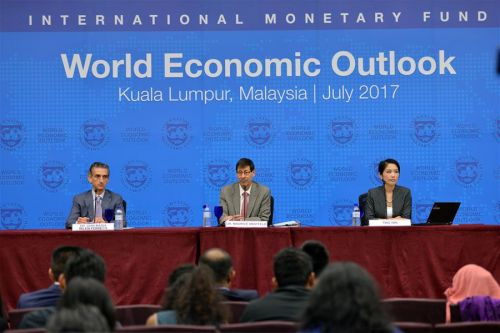
Maurice Obstfeld (C), chief economist of the International Monetary Fund (IMF) addresses to the media in Kuala Lumpur, Malaysia, July 24, 2017. The International Monetary Fund (IMF) on Monday revised up China's growth forecast for 2017 and 2018 to 6.7 percent and 6.4 percent respectively. (Xinhua/Chong Voon Chung)
KUALA LUMPUR, July 24 (Xinhua) -- The International Monetary Fund (IMF) on Monday revised up China's growth forecast for 2017 and 2018 to 6.7 percent and 6.4 percent respectively, with the better China prospects expected to drive global growth.
The updated World Economic Outlook (WEO) report, which came days after China posted a stronger-than-expected second quarterly performance, was a reflection of a solid first quarter underpinned by previous policy easing and supply-side reforms, including efforts to reduce excess capacity in the industrial sector, the IMF said.
"China is quantitatively a big contributor to the overall world growth picture. More generally, strong Chinese growth drives particularly Asian region but also throughout the world," said Maurice Obstfeld, chief economist of the IMF in an interview with Xinhua after the release of the updated report.
A CAUTIOUSLY OPTIMISTIC CHINA
The revision of 2017 followed an April upgrade by the IMF on China's GDP growth forecast to 6.6 percent and 6.2 percent for 2017 and 2018 respectively, 0.1 percentage point and 0.2 percentage point higher than its previous forecast.
China has set its full-year growth target for 2017 at "around 6.5 percent." The 6.7-percent forecast will leave the world's second-largest economy on a par with its growth level in 2016.
The fund also revised up China's economic forecast for 2018 by 0.2 percentage point to 6.4 percent, citing expectations that China may maintain high public investment and delay fiscal adjustment to meet its target of doubling the 2010 real gross domestic product (GDP) by 2020.
But the IMF also warned against strong credit growth that may come with rising downside risk to medium-term growth.
Obstfeld said the fund recognizes that China is going through a very important rebalancing process, which will inevitably entail a slowing path of growth.
He said China's recent moves to redress non-performing loans and a coordinated financial oversight overhaul are welcome.
"As I have said before -- what happens in China doesn't stay in China -- the spillover to the global economy is very large ... And it's very important for the world economy that China not just grows at a strong rate but that it grows in a stable fashion, dependable fashion without big fluctuation," said Obstfeld.
While highlighting China'a action in reforming and improving its financial oversight such as the centralization of financial oversight, Obstfeld also noted the necessity for China to push forward structural reform on state-owned enterprises (SOEs), suggesting that China needs to put SOEs on firm budgetary basis and think harder on the financial sector.
A FIRMING GLOBAL RECOVERY WITH SLOWER U.S.
On the global perspective, the IMF said the pickup in global growth recovery remains on track, maintaining its previous forecast of global growth at 3.5 percent and 3.6 percent respectively for 2017 and 2018.
However, it revised down the growth forecast of the United States from 2.3 percent to 2.1 percent in 2017, and from 2.5 percent to 2.1 percent in 2018, primarily reflecting the assumption that fiscal policy will be less expansionary than previously anticipated.
Another country with lower growth forecast for 2017 is Britain with its weaker-than-expected activity in the first quarter.
By contrast, projections of most developed economies in the euro zone, Japan and Canada were revised up due to positive activity in late 2016 and early 2017, which helped maintain the 2 percent growth projection for advanced economies.
While the IMF posted a challenging outlook for growth in the Middle East and North Africa, solid performance in the first quarter of 2017 in China, India, Southeast Asia and Turkey led the IMF to forecast growth for emerging and developing economies at 4.6 percent in 2017, up from 4.3 percent in 2016.
The growth forecast for advanced economies in 2018 is 1.9 percent, 0.1 percentage point below the April 2017 WEO, while for emerging and developing ones, the growth forecast remains at 4.8 percent.
MEDIUM TERM RISKS
While short-term risks are broadly balanced, medium-term risks are still skewed to the downside, the IMF report said.
Rich market valuations and very low volatility in an environment of high policy uncertainty raise the likelihood of a market correction, which could dampen growth and confidence, Obstfeld noted.
"There are some advanced economies where their corporate debt and public debt levels are high, and normalizing interest rates might put some strain on companies and sovereigns to repay those debts. These are things we are watching, they are not red alerts at the moment but we have to beware of these risks," he explained.
He also said the monetary policy normalization in some advanced economies, notably the United States, could trigger a faster-than-anticipated tightening in global financial conditions, which may have a ripple effect on Asian economies.
On protectionism, Obstfeld said it was not a new problem as since the global financial crisis, various protectionism measures have been taken.
"Protectionism is an increasing trend, we have seen the U.S. withdrawing from the TPP (Trans-Pacific Partnership)...we have to wait and see the impacts," he said.




 A single purchase
A single purchase









